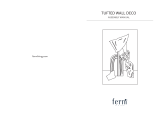
©2017 Aladdin Commercial
|
aladdin-commercial.com
|
1.800.2MOHAWK
Direct Glue-Down Installation
Carpet Installation Check List
1. Newly poured concrete oors generally will take 90 to 120 days to cure. Moisture should not exceed 5 lbs./1000sf per 24
hours as determined by a calcium chloride test per ASTM F1869, or 80% relative humidity per ASTM F2170. If the results
are more than 5 lbs. or higher than 80%, do not proceed with the installation. Contact Field Services at 1.888.387.9881.
Gypcrete or substrates with excessive dust must be cleaned, and then primed with Mohawk Industries’ PrimeCoat or an
approved primer, such as a latex milk additive.
2. The alkalinity or pH in a concrete slab should be between 5 and 9 for a glue-down installation. When pH is between 9-12
and moisture is below 5 lbs. or 80% then PrimeCoat can be used to block pH. Should the pH be outside this range, stop and
do not proceed with the installation. Contact Field Services at 1.888.387.9881.
3. The oor and room temperature must be acclimated by maintaining the temperature at 65° F and 95° F, and the humidity
between 10% and 65%, for at least 48 hours before, during, and 72 hours after installation. In addition, the adhesive and
seam sealer should be stored under these conditions for at least 24 hours before installation. The installation site must be
acclimated with HVAC in operation.
4. Old adhesive must be properly removed prior to any installation of Mohawk Industries’ branded carpet. When cutback
adhesive is present or existing adhesive has indications of plasticization or PVC-backed products are being installed, then
SureSeal must be applied after the old adhesive has been properly removed. See note #1.
5. Mechanically remove all wax, dirt, grease and paint. DO NOT use solvents to clean the oor. DO NOT use oil-based
sweeping compound. Fill cracks more than 1/16" wide with a Portland or cement-based patching compound. The oor must
be at to within 1/8" in 10 feet. Use leveling compound when required. Patched areas may need to be primed (consult patch
manufacture for requirements) with PrimeCoat or an approved primer. DO NOT install over resin or silicate-based curing
compound.
6. Carpet should only be bent when absolutely necessary for transporting purposes only and must be unrolled immediately.
Carpet should be rolled out and allowed to relax for at least 24 hours prior to installation.
7. Never cut carpet over carpet, as this can result in over-penetration of the blade and cutting loops on the lower carpet. Never
install broadloom carpet over carpet.
8. Carpet should be protected from heavy trafc and construction dust with a non-staining building material paper. Never use
plastic sheeting as it will trap moisture and prevent proper curing of the adhesive. Plastic may also leave residues that can
result in rapid soiling after removal.
9. Furniture placement and heavy trafc should be avoided for at least 24 hours after a direct glue-down or double glue
installation. Furniture and heavy equipment apply concentrated pressure, and movement over unprotected carpet can cause
adhesive breakdown. This can result in buckling and / or wrinkling. It is strongly recommended that plywood or masonite
boards be placed over the carpet during the move-in phase to spread the concentrated weight of furniture and heavy
equipment.
PLEASE NOTE
1. Asbestos-containing oor tiles, any adhesive possibly containing asbestos, or other asbestos-containing oor coverings
require special preparation, handling, and removal procedures. Consult the appropriate local or state authorities or the
Resilient Floor Covering Institute before disturbing any suspected asbestos-containing material.
2. Unitary and attached cushions can only be installed by the direct glue method.
3. Installation of Mohawk Industries’ branded carpet and carpet tile on a oor outside the scope of the guidelines in this
document will void all applicable warranties.
4. Mohawk Industries is not responsible for any product failure due to improper oor preparation and / or installation
procedures. The required adhesives are Mohawk Industries’ family of adhesives.





